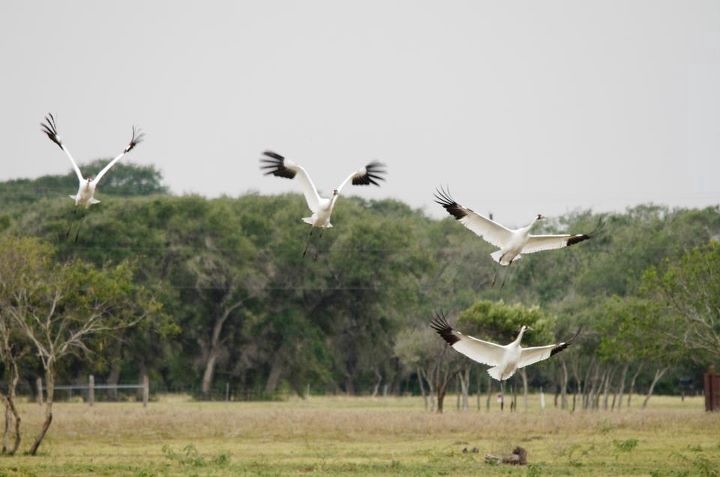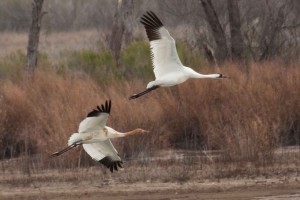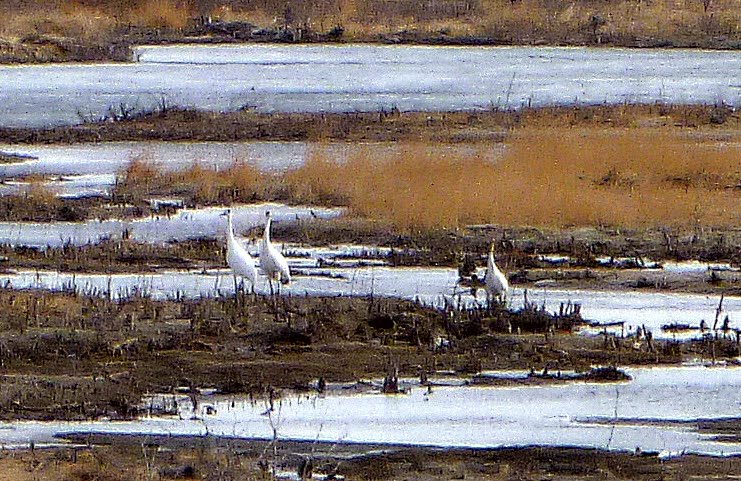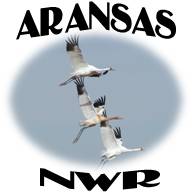Author Archive
Whooping Cranes on Aransas and Private Lands
March 1, 2012Whooping crane aerial census surveys were completed a second time on Aransas Refuge in February. But analysis of the information is not yet complete. According to refuge officials the February aerial survey has had some challenges due to weather but they are continuing their efforts. The updated census information will be posted on the website as soon as it becomes available. Meanwhile the interested public must rely on the January survey information that indicated the population of cranes to be 245 individuals. Aransas officials caution that this number does not reflect whooping cranes outside the survey area, including those that have dispersed. Whooping crane biologist and many thousands of whooper followers have been hoping for a total population count of 300 this year.
The unusual warm weather and extreme drought conditions in Texas are believed to be a primary cause for the dispersal of whooping cranes this year. Normally the birds remain mostly on Aransas National Wildlife Refuge during winter months with a few moving to nearby suitable locations. This year, however the whoopers are ranging further out from the refuge with some as far north as Nebraska. Citizen observation reports made to the Whooping Crane Conservation Association detected whoopers in Nebraska, Kansas, Oklahoma and eight counties in Texas.
- Figure 1. Whooping cranesmaking use on private land in Texas.
Some good news is that, as of February 29, the precipitation totals for Aransas, TX are 3.75 inches. Also, heavy rains north of the Aransas Refuge brought much fresh water downstream to the bays and estuaries near the refuge. Salinity levels in San Antonio Bay are recorded as 20.4 parts per thousand. Salinity levels have dropped due to recent freshwater inflows from rain in Central Texas, as well as localized rainfall.
Since the last Aransas Refuge update, the refuge has conducted additional prescribed burns bringing the total to 10,852 acres of habitat. The whooping cranes have been observed eating the roasted acorns and other food sources. There are still approximately 1,110 acres planned for the remaining whooping crane season. The refuge had originally hoped to burn approximately 14,200 acres but weather conditions prevented firefighters from safely and effectively conducting the prescribed burns to help alleviate low food sources for the cranes.
Aransas Refuge Estimates 245 Whooping Cranes
February 17, 2012By Chester McConnell, WCCA
Aransas National Wildlife Refuge biologists now estimate the population of whooping cranes to be approximately 245 individuals within their survey area. This number does not include whoopers known to be in at least five other Texas counties and other states. Some of the birds are moving around off the refuge for reasons not fully understood. It is believed that the whoopers may be seeking additional food sources. The refuge’s January 2012 survey consisted of three flights conducted on January 26, 27, and 29th. Survey biologists searched Matagorda Island, San Jose Island, Blackjack Peninsula, Lamar Peninsula, Dewberry Island and Welder Flats. A second round of survey flights will take place in mid to late February.
Biologists are receiving many reports of whooping cranes outside the survey area in the following Texas counties: Matagorda, Refugio, Calhoun, Aransas, Williamson, San Patricio, Maverick, and Caldwell. Whooping cranes of the Aransas-Wood Buffalo population are also currently residing in other states as far north as Nebraska. These cranes are naturally supplementing their own food sources by wintering around freshwater lakes and other marshes.
Refuge personnel continue to help alleviate low food resources by doing more prescribed burns. This winter they have burned 8,095 acres of habitat. Whooping cranes have been observed eating the roasted acorns and other food sources in burned areas. An additional 6,129 acres are planned to be burned while whooping crane remain on their winter habitat
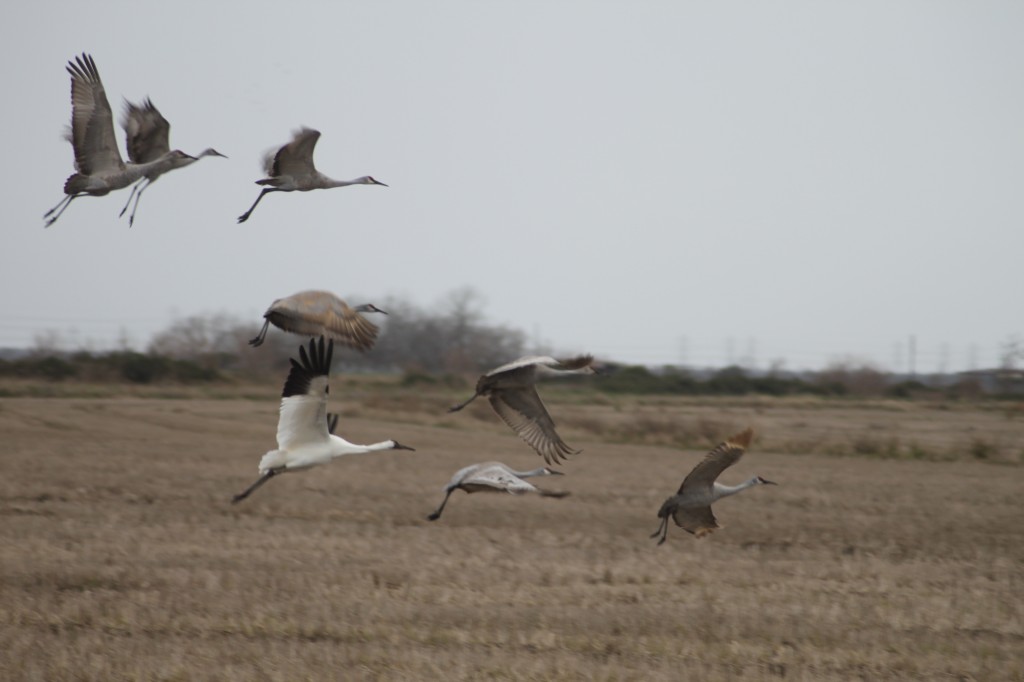
- Whooping crane with sandhill cranes in Texas rice field. Photo by Leanne Sliva
Fortunately some rains have fallen of Aransas Refuge recently. The first two weeks of February produced a total of 1.89 inches of rain. Water salinity levels have dropped due to recent freshwater inflows from rain in Central Texas, as well as localized rainfall. Salinity levels in San Antonio Bay are currently recorded as 19.9 parts per thousand. Salinity levels in surrounding bays still remain higher than normal which forces whooping cranes to expend more energy flying to fresh water sources.
Methods of counting whooping cranes on Aransas Refuge have been modified. Refuge official, Vicki Muller explained: “In previous years, the refuge gauged the whooping crane population by counting individual birds within the survey area. The aerial surveys objective was focused on counting every individual bird regardless of where they were located within the survey area. This technique is no longer feasible because the population is increasing. Biologists are flying along a transect, straight lines set at specific distances within the survey area. Previously each survey consisted of a single flight; now one survey includes three flights on three separate days (weather permitting) within a preset timeframe. The birds counted represent an estimate of the population within the surveyed area. It is expected that some birds will be not be included in the count, but this method (known as Distance Sampling) is commonly used to determine rare and endangered wildlife populations, including fin whales, Karner blue butterflies, and raptors.”
Aransas officials explain that, “Over the years the whooping crane population has been growing, the habitat changing, and the birds naturally dispersing. The primary goal is to ensure the recovery of the species and to do that the refuge and its partners must adjust with the ever-changing conditions. In 2009, biologists began putting radio telemetry bands on the cranes. Using leg snares, and other trapping techniques, the birds are captured and equipped with GPS leg bands. This technology records birds locations and allows biologists to learn which habitats they are using, where they stop during their migration, and much more. This technology is extremely valuable but it will be several years before sufficient data from the individual birds can be collected and fully analyzed. It will take a considerable more amount of time before the data will reflect patterns of the population as a whole. To date, the refuge and its partners are tracking approximately 30 whooping cranes with leg bands.”
Whooping Crane Update, February 16, 2012
February 17, 2012Aransas National Wildlife Refuge reports that a new census technique is being used to estimate whooping crane numbers on the refuge. The estimated number of birds, based on three aerial flights within the survey area is 245. This does not include birds known to be in 5 Texas counties and other states. Recent rain fall has helped lower the salinity levels in area bays where the whooping cranes feed. Click on link to read full report: wc update 2_16_12
Whooping Crane Update – February 2, 2012
February 7, 2012Whooping Crane Update wc updated 2_2_12 #2
Aransas National Wildlife Refuge provides its Whooping Crane Update, February 2, 2012. The report contains current numbers of whooping cranes counted by an aerial survey, habitat conditions on the refuge and rain fall updates.
209 Whooping Cranes Counted on Aransas NWR
February 3, 2012by Whooping Crane Conservation Association based on Aransas NWR report
Aerial surveys of the whooping crane population wintering on the Aransas National Wildlife Refuge were performed by U.S. Fish and Wildlife Service biologists last week. Refuge biologists have just completed their analysis of the census data and made their findings available. Three aerial surveys were conducted. A survey on January 26th was cut short due to high winds. Surveys conducted on January 27th and 29th were approximately 4 1/2 hours and each systematically searched Matagorda Island, San Jose Island, Blackjack Peninsula, Lamar Peninsula, Dewberry Island, and Welder Flats. Conditions for surveying were most favorable on January 29th, when observers detected 193 whooping cranes. Of the 193 cranes, 125 were white plumage birds, 23 were juvenile birds, and 3 were undistinguished.
The numbers do not represent a complete “census” of birds in the surveyed area, but will provide biologists a means to estimate the whooping crane population size. It is possible that some of the whoopers on the refuge were not detected by the observers. Analysis of these data is ongoing.
At least 16 additional Aransas-Wood Buffalo population of whooping cranes are currently residing outside of the typical wintering area, as far away as Nebraska. Based on the available data, 209 whoopers have been accounted for. The next survey flight will be scheduled for mid-February.
Approximately 5% of whooping cranes detected on the 27th and 29th were found using man-made freshwater sources, such as stock ponds and windmills. Cranes were using both upland and marsh communities. They are naturally supplementing their own food sources by wintering around freshwater lakes.
Refuge personnel continue to help alleviate the low food resources by adding to the prescribed burn totals. This winter the refuge has burned 8,095 acres of habitat that have recorded whooping crane usage. Biologists observed the whooping cranes eating roasted acorns and are seeing continued use. There are still an additional 6,129 acres planned to be burn for the remaining whooping crane season.
Many people have inquired whether the refuge plans to implement a supplemental feeding program for whooping cranes this winter. At this time, refuge officials are concerned about the negative impacts of supplemental feeding. Previous efforts to supplemental feed were not considered successful as only a small portion of the birds actually fed on the shelled corn.
Whooping cranes are territorial and do not naturally gather together to feed. Encouraging them to do so changes their natural behavior; it also creates greater opportunities to transmit diseases, parasites, and makes them more vulnerable to predators. Furthermore, when left out in warm and moist environments, like coastal marsh areas, corn can grow Aspergillis molds. Aflatoxins, which are produced by the molds, can be lethal to whooping cranes and other wildlife. Where whooping cranes may be present, landowners should be aware of the risks that aflatoxins pose. If corn is being be used for feeding other wildlife in areas where whooping cranes may be present, U.S. Fish and Wildlife Service scientists highly recommend purchasing aflatoxin-free corn.
Aransas National Wildlife Refuge has received 0.84 inches of precipitation for the month of January. Central Texas has been fortunate to receive some much needed rainfall recently and the water has raised the Guadalupe River to above flood stage levels from Jan 28th- Jan 31st. This river flows into the San Antonio Bay and the flush of freshwater is expected to further decrease salinity levels. Currently, salinity levels are reported to be 23.2 parts per thousand (ppt) compared to 35.3ppt on December 14, 2011.
January 24th data from Texas Parks and Wildlife Department indicates that samples taken in the San Antonio, East Matagorda, and Espiritu bays were free of red tide. It
is still persisting in some of the surrounding bays but in very low concentrations.
Aransas Refuge officials reported that a second radioed whooping crane chick has died this winter since their last report. The carcass has been sent off for testing and we are awaiting results.
Citizens Help Monitor Whooping Cranes
January 30, 2012by Chester McConnell, Whooping Crane Conservation Association
Excitement is rampant in many thousands of bird watchers when whooping cranes begin their migration from Buffalo National Park, Canada southward to Aransas National Wildlife Refuge, Texas. Birders get a high when they are lucky enough to spot an endangered whooping crane and add it to their life list of birds observed. To many it is the “crown jewel” of their observations. Such spotting’s are discussed at ornithology meetings, boasted about at cocktail parties and even announced at church. “Really, we are fortunate when blessed with seeing one of the approximate 300 whoopers in the last remaining wild flock” said Dorothy McConnell, Daphne, AL. Dorothy and her husband have traveled all along the 2,500 mile migration route to watch whoopers and other birds.
Many birders take their whooping crane sightings one step more. They report their observations on the Whooping Crane Conservation Association’s web site at https://whoopingcrane.com/report-a-sighting/ . The Association analyzes the reports, plots the sightings on a map and sends the reports to officials in the U.S. Fish and Wildlife Service. Reports are forwarded to either of two Service offices depending on whether the whoopers were spotted west or east of the Mississippi River. The reports by citizens are used by the Fish and Wildlife Service along with reports from its own team of federal and state spotters.
Western sightings are primarily from the Aransas-Wood Buffalo flock with a few from the non-migratory experimental flock in Louisiana. Most the eastern sightings are from the Wisconsin-Florida experimental flock or the non-migratory Florida flock. The Whooping Crane Conservation Association received approximately 150 reports from citizens during the past five months. All of the reports are evaluated and assist the federal officials in their monitoring responsibilities.
Reports start arriving to the Association soon after the whoopers depart from Wood Buffalo NP. Approximately 15 reports were received from Canada during September and October. A month later reports arrived from North Dakota, Nebraska, Kansas and Oklahoma. Most of the recent reports have been from Texas. Just this morning Jorjanna Price sent a report of three whoopers in a pasture in Refugio County, TX. This sighting was near Aransas Refuge, winter home of whooping cranes. Other reports came from Rebecca Alderson of two adult whoopers in south central Kansas; Rob Vinson spotted one adult bird in southeast Missouri; two other reports from Tracy Wisenburg of six whoopers and Byron Stone of three, both in Granger Lake, Texas; eight birds were reported at Thorndale, Texas by Nadine French; Chris Flannigan spotted two adult birds near Seadrift, Texas; and Darren Schlessinger observed three (2 adults and 1 young) north of Austin in Stillhouse Hollow Lake, Texas.
The Association has received some unusual reports. Several birders reported five whooping cranes on private lands near the Quivira National Wildlife Refuge and Cheynne Bottoms State Wildlife Area in south central Kansas. These birds have been detected there since December 2011. Dan Severson, Quivira’s Refuge Manager believes that due to the mild winter and plenty of food, these birds may just remain in the area all winter rather that migrating to Aransas Refuge as usual.
The most unusual report that Whooping Crane Conservation Association has received was last week from Bill Riggs, Nebraska. Bill reports that he observed three whooping cranes (two adults and one juvenile) in the Platte River vicinity. Bill told the Association that, “I was driving along and spotted the birds a little before noon. They were
still there when I came back the same route. I’ve been blessed to see whooping cranes several times, a few times one was traveling with the Sandhills. But usually I see them after they’ve (whoopers) already headed on north. The whoopers seem more inclined to wait for warmer weather, around mid-April to start their own journey back north. If I hadn’t seen these myself, I wouldn’t have believed this. I first thought maybe they could have been Great or Snowy Egrets; I’ve seen both out there, but these look like Whoopers, two adults and one juvenile, slightly smaller with just a bit of rusty color left from the neck up.” On a return trip to the site, the whoopers could not be located.
Texas Climate News article – climate effects on whooping cranes
January 21, 2012
 The whooping crane – the tallest bird in North America and one of the rarest – is the leading symbol of wildlife-conservation efforts in the United States. In 1941, the species’ total population had dwindled to 15 cranes, discovered wintering on the Texas coast. The American Birding Association reported a species population of 599 last September, including 278 cranes in the group that migrates 2,500 miles between nesting grounds in Canada’s Wood Buffalo National Park and wintering habitat around Texas’ San Antonio Bay, north of Corpus Christi.
The whooping crane – the tallest bird in North America and one of the rarest – is the leading symbol of wildlife-conservation efforts in the United States. In 1941, the species’ total population had dwindled to 15 cranes, discovered wintering on the Texas coast. The American Birding Association reported a species population of 599 last September, including 278 cranes in the group that migrates 2,500 miles between nesting grounds in Canada’s Wood Buffalo National Park and wintering habitat around Texas’ San Antonio Bay, north of Corpus Christi.Aerial Counts of Whoopers Scheduled
January 17, 2012Aerial Counts on Aransas Refuge Scheduled
By Chester McConnell, Whooping Crane Conservation Association
“Aerial survey flights to estimate the whooping crane population on Aransas NWR wintering grounds has been scheduled the week of January 23rd with the office of Migratory Birds within the U.S. Fish and Wildlife Service, according to Dan Alonso, Refuge Manager. Alonso also told the Whooping Crane Conservation Association that, “The aerial surveys will consist of 3 consecutive flights to increase the accuracy of the population estimate. We will post an update when biologists process the flight data.”
Whooping crane enthusiasts are elated with the news that census flights will soon begin. As late as last week Aransas officials had been not been able to secure a government certified pilot and aircraft to complete an aerial survey. Fortunately their diligent efforts resulted in getting the problem solved.
Aransas Refuge personnel have been doing their best under very trying circumstances. They drove the refuge roads in automobiles to count all whoopers within their view. On December 22, 2011 they observed 45 whooping cranes using upland and marsh communities. Coupled with one of the worst droughts in many years, red tides in bays along the Texas coast and low numbers of blue crabs (favorite food of whoopers), Aransas officials have had their hands full.
Despite potential threats this winter, whooping cranes continue to thrive and managers are doing everything possible to ensure their continued success. Aransas National Wildlife Refuge officials report that, “This has been a busy month for whooping crane activity since our last report in December 2011. Fortunately, the Refuge has received an additional 0.72 inches of precipitation but salinity levels remain higher than ideal.” The recent rains that came to Texas caused flooding in some areas but little of that fell on Aransas. Fortunately, temperatures have been higher than normal and whooping cranes have not had to face energy draining cold weather.
Refuge Manager Dan Alonso advised that, “We have continued to help alleviate the low food resources by adding to our prescribed burn totals. This week alone we have burned an additional 4,682 acres of whooping crane habitat. Biologists observed the whooping cranes eating acorns roasted by the fires and are seeing continued usage.”

Aerial Survey Delayed for Whooping Cranes
January 16, 2012By Chester McConnell, Whooping Crane Conservation Association
Has the number of whooping cranes currently wintering on Aransas National Wildlife Refuge attained the 300 population level as we have hoped? No one knows. Interested citizens from all over the United States and other countries have been waiting for months to learn if the record number of 300 birds was reached.
Aransas Refuge officials advised the Whooping Crane Conservation Association that, “For reasons beyond our control, we are not able to secure a government certified pilot and aircraft to complete an aerial survey but are working diligently to alleviate this issue.” So, as of January 16, 2012 no refuge-wide count of whooping cranes has been done . The Association recognizes the dilemma facing refuge officials and hopefully the problem will be solved soon.
The Association believes that it is essential for aerial surveys to be conducted on Aransas NWR to inventory the total wintering population of whooping cranes. There is no other practical method to gather the data needed. Aerial population surveys help determine the total number of whooping cranes, pair bonds, numbers of immature vs. mature birds, deaths of individuals, territory expansions, habitat utilization, water management needs and other general information to assist in the proper management of these endangered species.
The Aransas refuge staff is doing the best they can to get a partial count of the whoopers. They report that a survey by automobile was conducted on December 22, 2011 throughout the Blackjack peninsula of Aransas Refuge. A total of 45 whooping cranes were observed. Of course this does not represent the total population of whoopers because much of the refuge cannot be observed from roads. During their automobile road survey refuge biologists stated that whooping cranes observed at the refuge have bright white feathers indicating their overall body condition is good.
Despite potential threats this winter, whooping cranes continue to thrive and managers are doing everything possible to ensure their continued success. Aransas National Wildlife Refuge officials report that, “This has been a busy month for whooping crane activity since our last report in December 2011. Fortunately, the Refuge has received an additional 0.72 inches of precipitation but salinity levels remain higher than ideal.” The recent rains that came to Texas caused flooding in some areas but little of that fell on Aransas.
Refuge Manager Dan Alonso ad vised that, “We have continued to help alleviate the low food resources by adding to our prescribed burn totals. This week alone we have burned an additional 4,682 acres of whooping crane habitat. Biologists observed the whooping cranes eating acorns roasted by the fires and are seeing continued usage.”
vised that, “We have continued to help alleviate the low food resources by adding to our prescribed burn totals. This week alone we have burned an additional 4,682 acres of whooping crane habitat. Biologists observed the whooping cranes eating acorns roasted by the fires and are seeing continued usage.”
One whooper chick was found dead from unknown causes on the refuge in December 2011. “The chick carcass was sent to the National Wildlife Health Center in Madison, WI last month and there were inconclusive findings on the intermittent report. We are awaiting the final report, which will include virology results” according to Vicki Muller, Wildlife Refuge Specialist.
The latest data from Texas Parks and Wildlife officials indicate that red tide is still persisting in the bays along the Texas coast but in lower concentrations. Biologists continue to keep a vigilant watch for signs of illness or disease.
Texas Coast and Whooper Law Suit
January 13, 2012Texas Coastal Update 2011
This summary of Jim Blackburn’s newsletter provides an oversight of several issues concerning the bays and estuaries on the Texas coast and their link to whooping cranes. Hopefully you enjoy this update as well as the poems that are now required reading at the end.
Whooping Crane Litigation
Wow. I just finished a two week trial before Judge Janis Graham Jack in federal District Court in Corpus Christi, and I am still somewhat in a daze. It was the experience and event of a lifetime. I felt like I had been learning and practicing for thirty years for this case. I represent The Aransas Project (TAP), a non-profit group formed to protect San Antonio and Aransas Bays in an attempt to secure freshwater inflows for this important estuary. TAP filed suit against the Commissioners and the Executive Director of the Texas Commission on Environmental Quality (TCEQ) and the South Texas Watermaster for violating the federal Endangered Species Act. We alleged that the TCEQ allowed so much water to be removed from the San Antonio and Guadalupe Rivers that the bay salinity was changed beyond what the drought would cause, leading to less food supply for the Whooping Cranes, altering the drinking water supply of the whooping cranes and ultimately causing the death of 23 cranes during the winter of 2008-2009. The trial lasted for about two weeks.
Fresh off the whooping crane litigation, I want to engage in a rambling discourse about Texas water law, an archaic system that must be changed if we are to ever save our bays and estuaries. Texas water law and practice killed Nueces Bay. Of that there is no doubt. Nueces Bay at one time was a flourishing estuary. It is now officially classified by the Bay and Basin Expert Science Team (BBEST) formed under SB 3, as unsound due to inflow alteration, whereas every other estuary on the coast is still considered to be ecologically sound. We have proven that we can kill an estuary. Now is the time to start saving some.
Texas surface water is owned by the State of Texas. Use of state water is authorized by Certificates of Adjudication and permits and by statutory exemption. Although we the people own the water, we don’t act like it. We as citizens need to become as concerned about the protection of our public property as we are about protection of private property.
To read Jim Blackburn’s entire newsletter click on the following file: https://whoopingcrane.com/wp-content/uploads/2012/01/Coastal-Update-2011-Whoper-Law-Suit-Blackburn.docx
